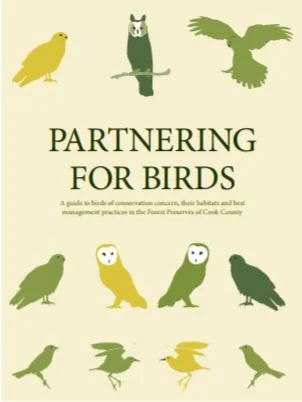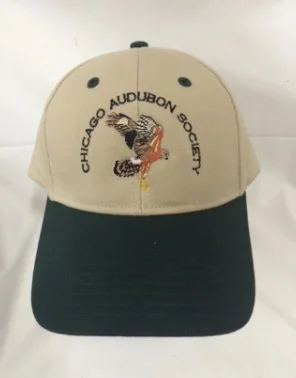Having a feeder keeps us in touch with our colorful neighbors in our own backyards., but what are the trade-offs?
Craig Stettner Remembered
by Alan Anderson, CAS Board Member
The Chicago Audubon Society lost a friend, a warm and helpful person, an educator and an excellent birder during a tragic accident while swimming in the ocean in Costa Rica with his family on Christmas Day. But when Craig Stettner unexpectedly passed away that day, so many more were affected: • Students at Harper College, where Craig taught Environmental Science and Biology since 1994 • The Forest Preserves of Cook County, where he spent many hours working to clear invasive species and to restore habitat at Spring Creek Forest Preserve • Citizens for Conservation • Friends of Busse Woods, where he was a board member • The Dragonfly Monitoring Network, which he coordinated from 2005-2011 And, of course, especially his family. Craig really loved his family, frequently making the trip to the Madison, Wisconsin area to spend time with his niece and nephews there. He spent many hours caring for his father who suffered from dementia. After his father passed, Craig visited his elderly mother every evening, to ensure she was well cared for, according to his brother David. One thing is certain. Craig loved birds. David says, “Craig had handwritten bird lists just about everywhere, his car, mom’s house, his house, his attic, I keep finding them. I think we are all amazed he was not in more accidents. His eyes were in the skies more than the roads when he was driving.” Craig began his involvement with Chicago Audubon Society in 2008 on the Illinois Spring Bird Count, when he helped cover a number of forest preserves along the Des Plaines River, as well as a few areas near Harper College. He faithfully helped with the Spring Bird Count every year thereafter, and, because he was an excellent birder with keen eyesight and a ‘great birding ear’, he almost always found some uncommon species on those days. He even found a Sora in his mother’s yard that first year! Craig participated in Christmas Bird Counts and surveyed a number of Northwest Cook areas for nesting birds. Craig joined the Chicago Audubon board in 2012 and actively served on the board until the present. He gave several programs for CAS, including one on dragonfly identification (one of his other specialties) and one on Costa Rica. He led many bird walks, including CAS Birdathon fundraisers. Craig was known for helping ‘wherever needed’ at all our Birding America Symposia (even standing outside to direct participants to the lunch hall — a very important little detail!). He was a regular volunteer at CAS birdseed pickup days helping many folks get their seed bags to their cars. Julie Sacco, former CAS board member and Naturalist at North Park Village Nature Center, said “I always had a great time working with Craig at the CAS birdseed sale because he always smiled, he was always there to sling 40- pound bags and he always checked on fellow volunteers to see if anyone needed anything, from a hot coffee to a pair of gloves.” Another CAS board member said of Craig, “He seemed to have a knack for lending support to others, no matter the relationship or situation. Clearly, he had a humanitarian gift.” Always humble, always helping, always volunteering, always trying to make others happy. The large church where his Memorial Celebration was held was packed with people whose lives Craig had touched. The most striking theme was how much Craig cared about people – really cared. He had so much love. Craig was a great example of just how much influence a good teacher can have in his community and world. He was not just ‘a teacher’ at Harper College. Former student Jennifer Chung said, “He cared about his students. He wasn’t just a professor — he was also a mentor.” He often brought his students into the natural world with excursions outside the classroom. He regularly led trips to Costa Rica to introduce students to the rich flora and fauna of the rainforest. Here are some of the words that Harper students used to describe Craig: Humble, patient, kind, caretaker, educator, altruistic, friend, saint, contagious, brilliant, loyal, dedicated, brave, philanthropist, encourager, optimistic, empathetic, compassionate, funny, quirky, gentle, inspirational, unforgettable, a mentor, friend, selfless, Godly, loving unconditionally, eco-warrior. Many students have said that Craig influenced their choice of profession. Bill Waltrich said he “was the reason I pursued a career in natural resources.” The Chicago Audubon Society plans to honor and remember Craig’s contributions in a number of ways. The CAS Board has renamed our Education Award “The Craig Stettner Award for Environmental Education.” We will have a field trip in his honor in April at Penny Road Pond and adjacent Spring Creek Forest Preserve, where he did so much ecological restoration. Donations to CAS in memory of Craig will be divided between a bench or plaque in the Spring Creek Forest Preserve remembering Craig’s restoration work there and a continuing scholarship in his name in environmental education at Harper College.
Craig received the William H. Miller Conservation Award from the Barrington-based Citizen’s for Conservation in 2013. In response Craig stated, “I’m honored to be the recipient of an award that’s linked directly to conservation. My goal every year is to expose my Harper students to real ecological work in the hope that it inspires them to learn even more about biology, the environment and ecology, and our role in all of it. They’re able to help a good cause, while learning, and that to me is the real reward.” Mission accomplished, Craig, but we will all definitely miss you!
Partnering For Birds - A Guide to Birds and their Habitats in the Forest Preserves of Cook County
Compass Newsletter, March - April 2019
Bird Friendly Design Ordinance Introduced in Chicago City Council
January 23, 2019 – Alderman Brian Hopkins (2nd Ward) introduced in Chicago City Council today the Bird Friendly Design Ordinance (O2019-320).
The ordinance establishes bird safe building material and design standards for new building construction in an effort to reduce bird mortality from circumstances that are considered to be “bird hazards.” In introducing the ordinance, Hopkins noted that “over the past several decades Chicago has taken action to make our beautiful city a less hazardous place for the millions of birds that pass through here, especially during the migration season. This ordinance makes the powerful statement that as we build an ever more vibrant and dynamic city, we will do so in a way that minimizes our city’s negative impact on native and migratory birds.” The ordinance builds on similar ordinances in other North American cities like San Francisco and Toronto, and it enjoys the support not only of conservation groups, but also architects and other design professionals. Jeanne Gang, Founding Principal of architecture practice Studio Gang, points out: “If we keep environmental impact in mind from the start of the design process, we can create buildings that are functional and aesthetically pleasing, and also bird friendly. This ordinance is a great step forward by a city with a history of groundbreaking architectural advancement.”
The Bird Friendly Design Ordinance championed by Alderman Hopkins is the dedicated mission of Bird Friendly Chicago, an alliance to promote a safer urban environment for birds. “Nationwide, as many as a billion birds are killed every year in collisions with buildings,” says Annette Prince, chair of Bird Friendly Chicago and director of Chicago Bird Collision Monitors. “The average Chicagoan is distressed to see the toll our buildings take on birdlife, but they are heartened to realize that we have it in our power to significantly reduce these tragic deaths. This ordinance is a win-win for the people of Chicago and for the birds that enrich our lives and that are crucial for a healthy environment.” - more - David Willard, Collection Manager Emeritus, Bird Division, at the Field Museum, added: “This ordinance is a sensible response to decades of hands-on research in bird collisions conducted by the Field Museum and others, and it fits hand-in-glove with the work that both the Chicago Park District and the Cook County Forest Preserves are doing to preserve and restore our natural areas.”
The ordinance, which does not apply to existing structures or to detached homes, townhouses, two-flats or residential buildings of six units or less, was assigned for further review to the Committee on Health and Environmental Protection, and could be brought to the entire City Council for vote as early as April of this year. About Bird Friendly Chicago. Bird Friendly Chicago is an alliance of four organizations: Chicago Audubon Society, Chicago Bird Collision Monitors, Chicago Ornithological Society, and Illinois Ornithological Society. Its mission is to promote a safer urban environment for birds through improved lighting, landscaping and glass features of buildings. To learn more, visit www.BirdFriendlyChicago.org.
If you would like more information about this topic, please call Dan Lory at 312-622- 6752, or email at birdfriendlychicago@gmail.com
Chicago Audubon Society Strategic Plan 2019-2020
2017 Photography Awards
Book Review: The Meaning of Birds by Simon Barnes
Biennial Environmental Awards Banquet and Annual Members Meeting
Compass Newsletter, Jan - Feb 2019
Bird Song Ear Training Guide CD
Baseball Cap
Chicago Audubon's Harrier Hat featuring a Northern Harrier patch, is now available Chicago Audubon's Harrier Hat featuring a Northern Harrier patch, is now available for only $15.00 (add $3.00 for shipping) to Members and non-Members. Great colors, solid stitching, and an adjustable band. Contact our office at (773) 539-6793 or email us at cas@chicagoaudubon.org














